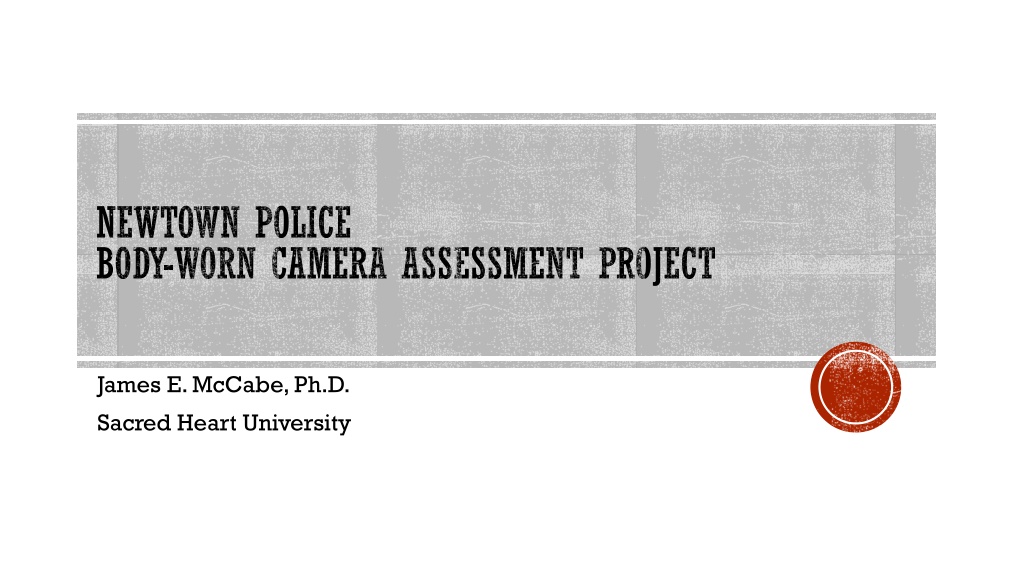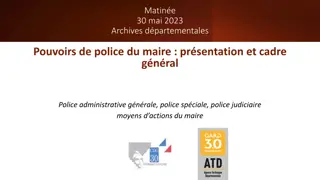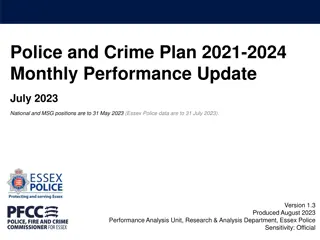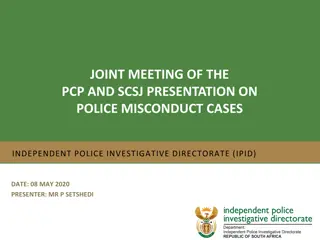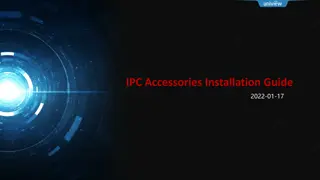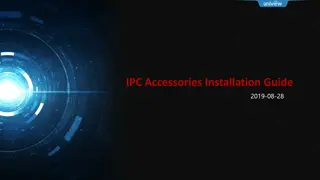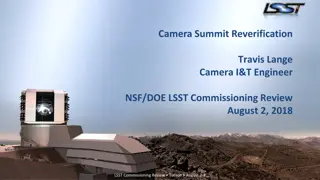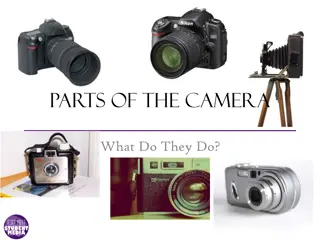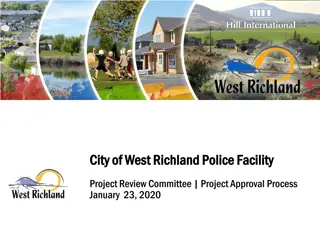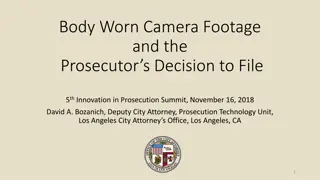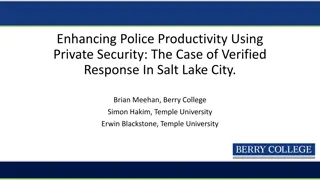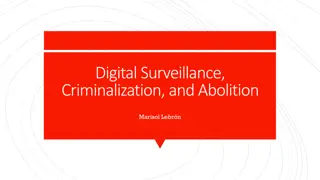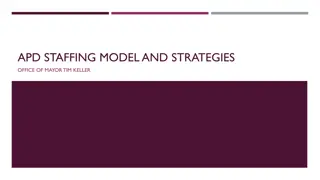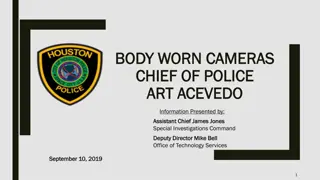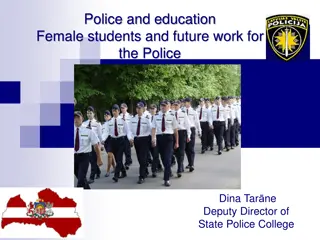Police Body-Worn Camera Assessment Project Overview
The Police Body-Worn Camera Assessment Project, conducted by Dr. James E. McCabe from Sacred Heart University, explores the impacts and implications of body-worn cameras (BWCs) on policing. The use of BWCs has increased significantly in recent years, leading to improvements in police accountability, community trust, and a reduction in civilian complaints. The project leverages data from BWC footage to evaluate police-community interactions, focusing on interaction quality, procedural justice, and the appropriate use of force. The study conducted by student researchers involved the systematic social observation of encounters captured in BWC videos, aiming to enhance understanding and promote fair and effective policing practices.
Download Presentation

Please find below an Image/Link to download the presentation.
The content on the website is provided AS IS for your information and personal use only. It may not be sold, licensed, or shared on other websites without obtaining consent from the author. Download presentation by click this link. If you encounter any issues during the download, it is possible that the publisher has removed the file from their server.
E N D
Presentation Transcript
NEWTOWN POLICE BODY-WORN CAMERA ASSESSMENT PROJECT James E. McCabe, Ph.D. Sacred Heart University
POLICE BODY-WORN CAMERAS First Generation UK in 2005 Ordered by Judge Scheindlin NYPD Stop and Frisk in 2013 Use in the U.S. increases after 2014 In 2013 only 21% of large police departments reported BWCs In 2018 more than 81% of large departments had cameras Recommended by President s Task Force in 21stCentury Policing Deployed in Newtown in 2017
POLICE BWC IMPACTS Police Accountability Video Evidence of Officer Conduct Improved community trust Reduction in civilian complaints Differing views on use of force (maybe policy related)
LEVERAGING THE DATA Impacts rely on Secondary Data Potential for Remote Supervision Tactics Communication skills Use of Force Evaluate the quality of police-community interactions Lawfulness Quality of the Interaction Procedural Justice
INTERACTION QUALITY Did the officer use force? Did that use of force seem appropriate? Did the officer escalated the encounter? Did the community member appear satisfied with the encounter?
PROCEDURAL JUSTICE Definition Four Pillars Procedural justice refers to the idea of fairness in the processes that resolve disputes and allocate resources It is a concept that, when embraced, promotes positive organizational change and fosters better relationships.
THE STUDY March and April 2020 Student Researchers from Sacred Heart 500 Randomly Selected BWC videos 100 selected weekly Populations ~ 3,800 videos Systematic Social Observation of Encounters
BWC ENCOUNTER DATA ENTRY FORM Rank: _____ Name: ____________ BWC FILE#_____________________ Type of Encounter _______________________________ Was notice given within a reasonable practical time that the encounter was being recorded? (Y/N) Was the BWC activated properly (1=Yes, 2=Started Late, 3=Ended Early, 4=Started Late and Ended Early)? _________ Where was the person first encountered (street, vehicle, lobby, etc.)? _________ What time did the encounter begin? _________ How long was the encounter? _________ What was the person s gender? _________ What was the person s race/ethnicity? _________ What was the person s approximate age? _________ Was any force used during the encounter? (Y/N) If force was used, what kind? ________________ Voice and Language Transparency -5 -4 -3 -2 -1 0 1 2 3 4 5 -5 -4 -3 -2 -1 0 1 2 3 4 5 Impartiality -5 -4 -3 -2 -1 0 1 2 3 4 5 Escalation -5 -4 -3 -2 -1 0 1 2 3 4 5 Satisfaction -5 -4 -3 -2 -1 0 1 2 3 4 5 COMMENTS_________________________________________________________________________ _____________________________________________________________________________________ _____________________________________________________________________________________ _____________________________________________________________________________________
Negative (-) Informal (My-Man, Hey you, Bro, etc.), Profanity used Positive (+) Formal (Sir, Ma am, Mr., Ms., etc.), Explanation provided Concern for well-being Voice and Language One-way, short, directive, Officer doesn t allow suspect voice, MOS doesn t listen Two-way; Conversation-like, Officer listens Aggressive, Hostile, Argumentative Friendly, Pleasant, Cordial Transparency No explanation was given and the person was not told given enough information to understand what was happening or to resolve their issue. The officer took active steps to describe what actions were being taken and how the person needed to do to resolve their issues. The officer seemed uninformed and/or how to handle the situation The officer appeared very knowledgeable of the law and procedures to deal with the situation Escalation It appeared that the officer was escalated the situation when not warranted situation The officer deescalated the situation. Impartiality It appeared that the officer was disrespectful to the person It appeared that the officer was respectful to the person The officer favored one party over the other during the encounter The officer exercised fairness in the encounter and remained neutral between any parties during the encounter Satisfied The person encountered appeared dissatisfied with the officer The person encountered appeared very satisfied with the encounter
RESULTS - DEMOGRAPHICS Age 16-20 20-30 30-40 40-50 50-60 Over 60 UNKNOWN Grand Total # 22 101 84 96 55 48 94 500 Gender # Race # Female 211 Asian 4 Male 224 Black 34 UNKONWN 65 Hispanic 41 Grand Total 500 White 331 Other 4 Unknown 86 Grand Total 500
RESULTS ENCOUNTER TYPE Type Alarm Arrest Dispute General CFS Miscellaneous MVA Report Crime # 14 30 23 164 63 80 36 Suspicious Activity Traffic Stop Grand Total 7 83 500
RESULTS - LOCATION Location # Commercial/Building 327 Police Department Residence Street Unclear Grand Total 60 160 235 7 500
RESULTS USE OF FORCE # Force Used? No Yes 496 4 500 Grand Total All 4 observed uses of force involved open hand techniques. Two of these incidents involved Male/White subjects and the other two involved Female/White subjects. In all of these incidents the civilian encountered was hostile towards the police officer and the situation escalated to the point that the officer needed to uses open hand compliance techniques to manage the situation.
RESULTS - ESCALATION Escalation Rating -3 -2 0 2 3 4 5 Grand Total Count 1 1 34 1 6 5 387 435 % Rating 0.2 0.2 7.8 0.2 1.4 1.2 89.0 100.0 65 Videos were removed from this analysis because the characteristics of the person were unknown. The ambiguity of the event made it impossible to assess the level of escalation and procedural justice variables.
RESULTS PROCEDURAL JUSTICE VOICE Voice Rating Count % Rating 0 20 4.6 3 6 1.4 4 14 3.2 5 395 90.8 Grand Total 435 100.0
RESULTS PROCEDURAL JUSTICE TRANSPARENCY Transparency Rating % Rating Count 0 41 9.4 3 4 0.9 4 10 2.3 5 380 87.4 Grand Total 435 100.0
RESULTS PROCEDURAL JUSTICE IMPARTIALITY Impartiality Rating % Rating Count 6.2 0 27 0.7 3 3 1.8 4 8 91.3 5 397 Grand Total 435 100.0
RESULTS OVERALL SATISFACTION Satisfaction Score -5 -3 -2 0 2 3 4 5 Count 2 2 1 63 1 12 11 343 % Rating 0.5 0.5 0.2 14.4 0.2 2.8 2.5 78.9 Grand Total 435 100.0
RESULTS - SATISFACTION Both -5 scores involved the same encounter. The BWC videos were taken at two separate times and recorded a DWI arrest of a M/W/20-30. The defendant was belligerent, disrespectful, and hostile towards the officer. The other three negative satisfaction scores involved traffic stops where the motorists were not pleased about receiving a ticket. These encounters involved a F/B/40-50, a M/H/20-30, and a F/H/30-40.
